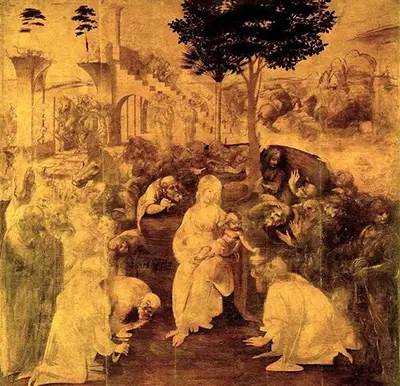Da Vinci was given 24-30 months in order to create this large oil on panel painting. He never finished it. Instead, da Vinci moved to Milan in order to secure a regular income from the Duke of Milan.
The Adoration of the Magi is fascinating piece. Since undergoing restoration and infra red analysis which began in 2012, even more of the picture and "underpainting" has come to light. Rather than answering questions it probably creates more.
The Adoration of the Magi shows the Christ child being adored by the three kings who bore the gifts of gold, frankincense and myrrh. In typical renaissance style, Mary sits centrally in front of the Tree of Life, creating a pyramidal shape which the viewer focuses upon.
Her sightline encourages the viewer to gaze with her across the child's head and then down his arm to the adoring Magi. Although this should be a nativity scene, there is no manger, stable or donkey. Instead there are many figures and a "confusion" of images in the background.
The rather ruined palace in the background is thought to be that of King David's and recent restoration now reveals that the knights on horseback are involved in an active battle scene. One of the horses has its head shown in several positions Also recently revealed are the constructions workers on the stairs.
At the far right of the painting there appears a shepherd boy which many have thought could be da Vinci's self portrait. Interestingly, the underpainting has been sealed with lead white which has ensured its preservation and some researchers have wondered whether another artist has completed some aspects of the upper layers.
What the Adoration of the Magi does reveal is how da Vinci constructed his work. He was a clever scientist and engineer. He was also fascinated with anatomy.
The almost skeletal appearance of some of the faces shows how he appears to draw them anatomically, adding the clothes afterwards.
He also uses a technique called sfumato, now called Leonardo's Smoke, which gives the visual effect of a smoky or hazy atmosphere. He also uses a technique called "chiaroscuro" which uses light and dark shades to give more three-dimensional depth.
The Adoration of the Magi is a wonderful piece and continues to reveal many secrets as fascinating as the "Da Vinci Code".


